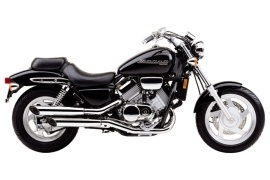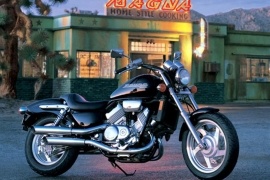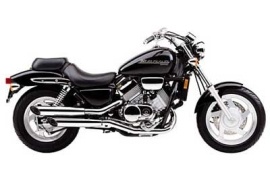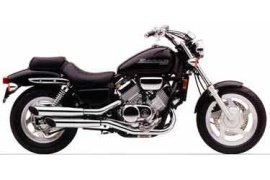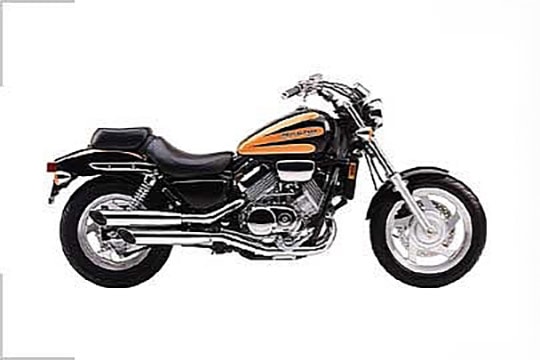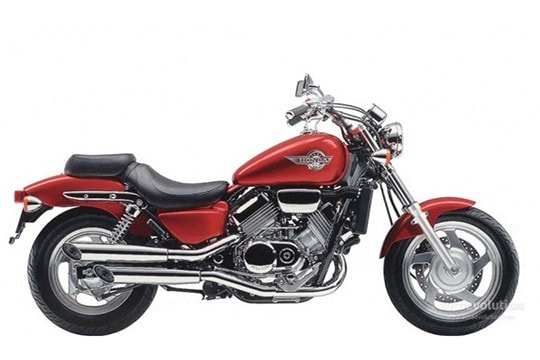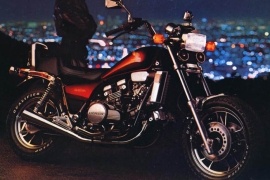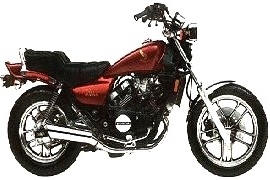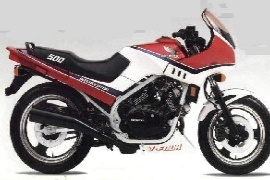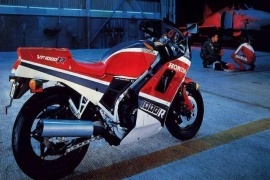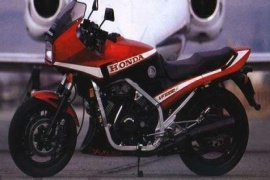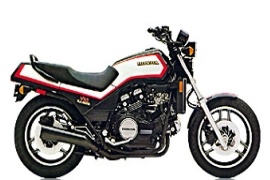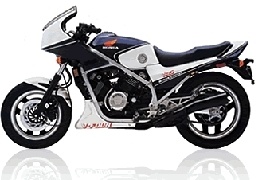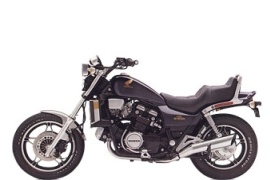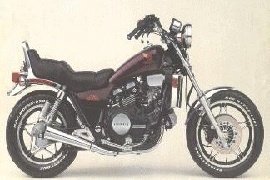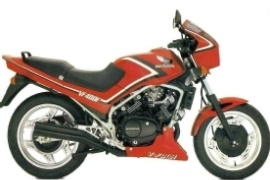HONDA VF Models/Series Timeline, Specifications & Photos
First production year: 1982
Honda Magna sits is a class of its own, as it is an intriguing build. Few expected that a middleweight cruiser be equipped with an engine derived from a sportsbike, nevertheless Honda made it happen. The VF750C Magna is powered by an engine derived from the VFR mill.
A V4 with characteristic sound and smooth, linear power deployment makes riding the 2002 Magna an unforgettable experience. And with 4 chromed exhausts, ample bars and a teardrop tank, the VF750C Magna is both bold and classy.
Powered by the sporty VFR V4 engine, the 2001 VF750C Magna is a cruiser in its own class. Low and slender, just like any roadster should be, the bike proudly shows of its amazing engine, while proving an unmistakeable rumble once the wheels start spinning.
With 4 silencers and a compact design, the Magna looks great: it's all about riding hard, and riding far. The yoke-mounted gauges and cast wheels, the bulbous, aggressive tank, are telling a serious rider's story. And with chromed luggage accessories and optional windshield, the Magna is ready for the long trip.
A sport bike engine powering a cruiser? Is this even possible? If the donor bike is the Honda VFR, and if the receiving end is Honda's Magna, this thing is not only possible, it is astonishing. With a V4 heart and its proven grunt, the 2000 Magna is a cruiser like no other.
With power and torque on tap, a glorious V4 sound and free-flowing 4-into-4 exhausts, the bike is as sweet a city slicer as it is a worthy companion for longer trips. Adding in some touring saddlebags and a windscreen will instantaneously transform the Magna in a road-dominating beast.
The 1999 VF750C Magna is the base model C4 cruiser Honda has in store for the thrill-seekers. This compact, low and mean machine packs a punchy V4 mill which delivers plenty of instant fun. Derived from the VFR one, the engine is quite happy to be ridden hard and makes the Magna a very agile motorcycle.
No matter whether you're in the cross-town traffic or blazing along the highway, the 1999 Magna is one of the unmistakeable machines. And with touring accessories, it can also be used for longer hauls through the country.
The Honda Magna needs no introduction: a spectacular presence in the biking world, this cruiser packs a V4 engine with a specific growl and power on tap, and will serve as a fast and mean city slicer as it will carry you toward the horizon, and the next one, and the next one...
Compact, muscular and with a sporty character, the 1999 VF750C2 Magna Deluxe is a glorious roadster, and Honda has multiple accessories for turning yours into a truly personal bike.
The Honda Magna was a cruiser motorcycle produced by Honda from 1982 to 1988 and 1994 to 2003. It was the second Honda motorcycle that packed the new V4 engine, which was also shared with the VF750S Sabre. Later models packed a re-tuned engine from the VFR750F.
In 1994, the Japanese motorcycle maker introduced the Honda VF 750 C Magna, a third-generation cruiser motorcycle, launched in 1993 as an early release for the 1994 model year.
Honda's means was to capture the powerful cruiser market by borrowing the engine from the Honda VFR750 and mounting it in a cruiser chassis. As for the engine's look, it was complemented by extra chrome, some extra cooling fins, and the four-into-four chromed exhaust system.
In addition, the engine suffered several changes, including a different crankshaft, a five-speed manual transmission, chain-driven cams, and smaller carburetors, resulting in a stronger mid-range pull and a broad power band.
The bike's visual department was characterized by standard fittings like a round headlight, a wide, pulled-back handlebar, a teardrop-shaped fuel tank, a two-piece dual seat with a low rider seat, and a detachable passenger unit, a four-into-four chromed exhaust system with two silencers on each side, and five-spoke aluminum alloy wheels.
In terms of power, the 1994 Honda VF 750 C Magna had installed a 748cc liquid-cooled four-stroke V-four engine underneath its fuel tank, delivering an output power of 87 hp at 9,000 rpm and 69 Nm (51 lb-ft) torque at 7,250 rpm.
In its first year of production, Honda V45 Magna was available in two colors, namely Candy Maroon and Candy Imperial Blue, had chromed headlight and fenders. Moreover, it was able to reach a top speed of 85 mph, while next year, the bike could run with a top speed of 240km/h.
It was equipped with a 748 cc DOHC 16-valve liquid-cooled 90 degree V-4 engine and, even if lots of changes were introduced over the next years, Magna was pretty much the same bikee. In 1987 , another Super Magna model came out, featuring a 700cc engine which produced 80bhp at 9500rpm.
The Honda Magna V30 was available in Candy Andromeda Red and Black and came with chromed and rectangular headlight, round horns, chain drive and a DOHC 4-valve liquid-cooled V-4 498cc engine.
Manufactured for only two years, between 1984 and 1986, the VF 500 F sport touring motorcycle produced by Honda is able to reach a top speed of 200 km/h.
First released in 1984, the Honda VF 1000 R came with numerous attractive features, such as the electronic starter system or the chain final drive. Moreover, its engine develops 130 horsepower at 10500 rpm and a torque of 92 Nm at 8000 rpm.
The VF 1000F has a liquid cooled, four stroke, 90 degrees, V four cylinders, 998cc engine which could develop 116 horsepower at 10000rpm and a torque of 86 Nm at 8000rpm.
After the V45 Magna Sabre and the Magna V65 had been introduced, there was the time for the V65 Sabre, an 1100cc V-Four. This bike, Honda's first 150mph production machine, had the same design as the V45, but on a larger scale.
Launched in 1983, the VF 750 Interceptor motorcycle was kept in production for only one year, till 1984.
Thanks to its V4 engine, the VF 1100 C, Honda's motorcycle manufactured between 1983 and 1985, is able to reach a top speed of 265 km/h.
The Honda Magna was a cruiser motorcycle manufactured by Honda from 1982 to 1988 and 1994 to 2003. It was the second Honda motorcycle that used the new V4 engine, also shared with the VF750S Sabre. Later models packed a re-tuned engine from the VFR750F.
In 1982, the Japanese motorcycle maker introduced the Honda VF 750 C Magna, a cruiser motorcycle also known as the VF750C and V45. It was part of the first generation, including a chromed headlight and chromed fenders.
The bike's visual department was characterized by standard features, such as a chromed front fender, a round headlight with a chromed housing, a wide, pulled-back handlebar, a one-piece, two-up seat with a small sissy bar, a chromed rear fender, side-mounted rear shocks, a dual chromed exhaust system with a silencer on each side, and five-spoke aluminum alloy wheels.
For suspension, the motorcycle packed a 39 mm air-assisted, four-way anti-dive adjustable telescopic fork on the front and dual shock spring preload-adjustable shocks on the rear, providing optimum handling capabilities.
As for the braking power, the bike's 18-inch front wheel was fitted with two 275 mm brake discs, while the 16-inch rear wheel was controlled by a drum braking unit.
Regarding power, the 1982 Honda VF 750 C Magna had its heartbeat set by a 748cc liquid-cooled four-stroke V-four engine managed by four 32 mm Keihin carburetors, boasting 79 hp at 9,500 rpm and 66 Nm (49 lb-ft) torque at 7,500 rpm.
The Honda VF 400 F was a naked, standard motorcycle manufactured by Honda for only two years, in 1982 and 1983. It was powered by a 400cc four-stroke V4 engine, had Honda's Torque Reactive Anti Dive Control (TRAC) system, and air-assisted suspension both front and rear.
In 1982, the Japanese motorcycle manufacturer introduced the Honda VF 400 F, a standard, naked motorcycle with a bikini cowl resembling the MVX250F model. The bike's engine was the perfect replica of Honda's VF750 model and had everything its big brother had.
The bike's aesthetic department was characterized by features such as a square headlight integrated into a bikini cowl, a small windscreen, a one-piece two-up seat with a passenger grab rail, a dual exhaust system with a silencer on each side, an engine spoiler, and aluminum alloy wheels.
The bike was built around a double-cradle steel frame with a telescopic, cylindrical air cushion fork on the front and a dual-sided swingarm with a single shock absorber on the rear, offering optimum handling capabilities.
As for power, the 1982 Honda VF 400 F had its heartbeat set by a 399cc four-stroke V-four liquid-cooled engine mounted at its core, boasting 55 hp with a peak at 12,500 rpm and 35 Nm (26 lb-ft) torque at 10,500 rpm.
